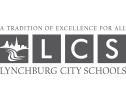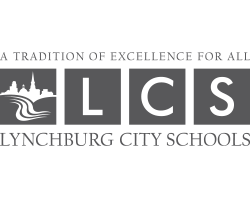Over the past several months, Lynchburg City Schools (LCS) has engaged with the community to gather feedback for the upcoming Facilities Master Plan. That feedback has been critical in helping to determine what LCS should look like in the future.
The aim of the Facilities Master Plan is to support student success by enhancing learning environments and by providing the best possible opportunities for the children of Lynchburg now and into the future. This must be done in a way that optimizes current facilities at LCS to address educational needs. The decisions made as a part of the master plan— including renovating, closing, and repurposing school buildings—have the potential to be challenging for the LCS community. Because of this, it is important that families, students, and staff are able to continue to provide input.
LCS has been working with education consultant MGT of America to develop the Facilities Master Plan. MGT is a consulting firm that helps school divisions throughout the United States take steps to improve their educational programming. In examining the educational needs of current and future students in Lynchburg, MGT has recommended that the following core actions should be taken in the near future:
- Rezone for Close-to-Home - To simplify transportation routes and provide considerable operational savings, attendance zones need to be extensively overhauled. A transition to close-to-home school boundaries would help achieve this.
- Improve Elementary Buildings - The building conditions of many elementary school buildings across the division are just not suitable for current and future students in Lynchburg. Renovations are needed, including safety and maintenance updates. As much as possible, elementary school buildings should also be built or expanded to accommodate 400 to 600 students where space allows in order to optimize the use of school buildings.
- Expand Pre-K Options - Pre-K programming will need to be expanded to meet the needs of the current applicant pool.
- Expand CTE - Career & Technical Education prepares students with work ready skills upon graduation, and expanded CTE offerings and facilities at both high schools is a necessity to provide more opportunities to students.
- Remove Portable Classrooms - Students should be learning in school buildings, not modular or portable classrooms.
With these core actions in mind, and based on previous community feedback about potential renovation, construction, consolidation, and rezoning, MGT has developed four possible scenarios for our community to consider and offer feedback. Financial considerations for each scenario have not been included so that initial feedback can focus on student impact. These scenarios are only potential paths forward and do not represent final recommendations.
These scenarios are only potential paths forward and do not represent final recommendations.
Scenarios
Scenario 1
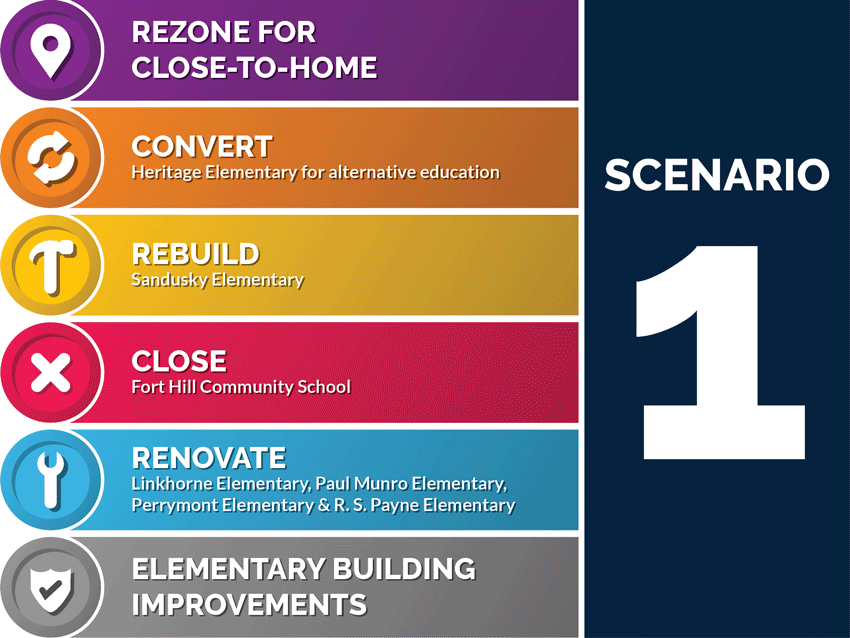
In Scenario 1, current attendance zones would be extensively overhauled to simplify transportation. This would primarily impact elementary attendance zones and provide considerable operational savings.
To support full-day alternative education services for middle and high school students, Heritage Elementary would be converted to an Alternative Program Academy. This location would be ideal given its proximity, yet physical separation from Heritage High School. With the new Alternative Program Academy, Fort Hill Community School would be closed.
Since Heritage Elementary would be repurposed, Sandusky Elementary would need to be rebuilt to accommodate a portion of current Heritage Elementary students and to balance enrollment from district wide rezoning. This new school building would also allow for optional Pre-K expansion.
Linkhorne, Paul Munro, Perrymont, and R. S. Payne elementary schools would be renovated to meet current and future needs of students. All other elementary schools would require building improvements to address safety and maintenance needs.
Under this scenario elementary utilization increases to +/- 89%.
For a more in-depth look at Scenario 1 and its potential outcomes, please view the Scenario document provided by MGT.
| Scenario 1 Community Benefits |
|
| Scenario 1 Community Trade-offs |
|
Scenario 2

In Scenario 2, current attendance zones would also be overhauled. Dearington Elementary would be closed or repurposed to support expanded Pre-K programming. As in Scenario 1, Linkhorne, Paul Munro, Perrymont, and R. S. Payne elementary schools would be renovated to meet current and future needs of students. All other elementary schools—including Heritage and Sandusky in this scenario— would require building improvements to address safety and maintenance needs.
Under this scenario elementary utilization increases to +/- 84%.
For a more in-depth look at Scenario 2 and its potential outcomes, please view the Scenario document provided by MGT.
| Scenario 2 Community Benefits |
|
| Scenario 2 Community Trade-offs |
|
Scenario 3
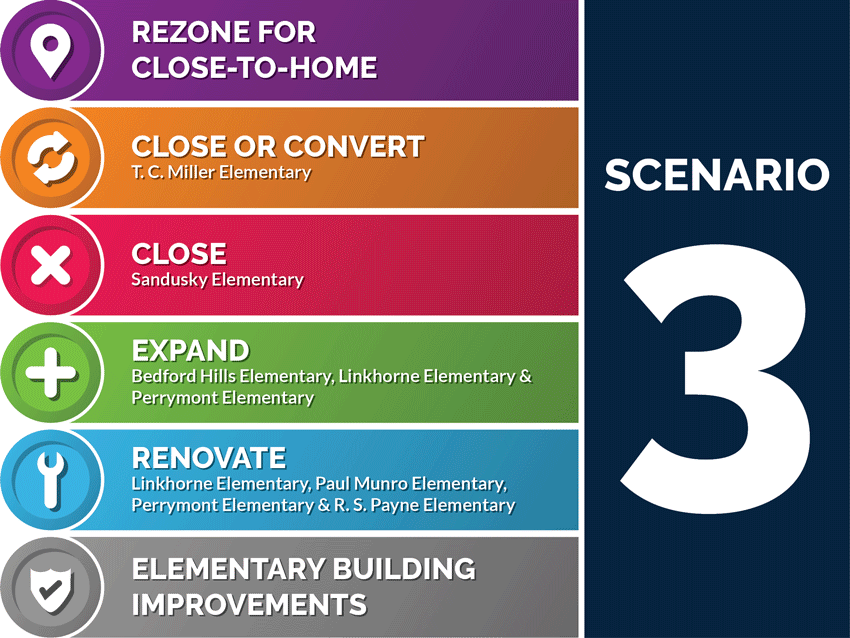
In Scenario 3, current attendance zones would again be overhauled. T. C. Miller Elementary would be closed or repurposed to support expanded Pre-K programming.
In this scenario, Sandusky Elementary would also close, which would require expansions at other elementary school sites to accommodate shifting student populations. Expansions would be required at Bedford Hills, Linkhorne, and Perrymont elementary schools. Linkhorne and Perrymont would also need additional renovations to meet student needs, as is the case at Paul Munro and R.S. Payne elementary schools.
All other elementary schools not already specified in this scenario would require building improvements to address safety and maintenance needs.
Under this scenario elementary utilization increases to +/- 84% with expansion at other sites. Without expansion utilization increases to +/- 92%.
For a more in-depth look at Scenario 3 and its potential outcomes, please view the Scenario document provided by MGT.
| Scenario 3 Community Benefits |
|
| Scenario 3 Community Trade-offs |
|
Scenario 4
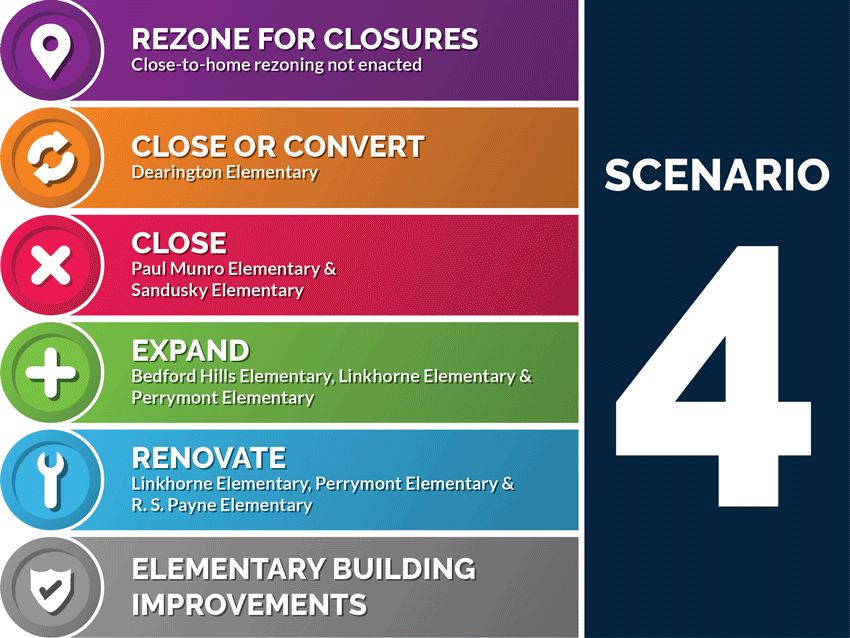
In Scenario 4, close-to-home rezoning would not be enacted; however, attendance zones would shift based on school closures. Dearington Elementary would be closed or repurposed to support expanded Pre-K programming.
In this scenario, Paul Munro and Sandusky elementary schools would also close, which would require expansions at other sites. Like in Scenario 3, expansions would be required at Bedford Hills, Linkhorne, and Perrymont elementary schools. Linkhorne and Perrymont would also need additional renovations to meet student needs, as is the case at R.S. Payne.
All other elementary schools not already specified in this scenario would require building improvements to address safety and maintenance needs.
Under this scenario elementary utilization increases to +/- 84% with expansion at other sites. Without expansion utilization increases to +/- 98%.
For a more in-depth look at Scenario 4 and its potential outcomes, please view the Scenario document provided by MGT.
| Scenario 4 Community Benefits |
|
| Scenario 4 Community Trade-offs |
|
